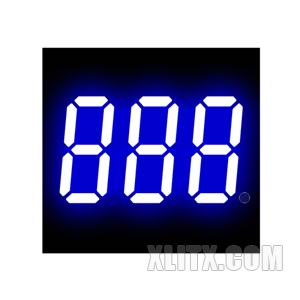PWM (pulse width modulation), using simple digital pulse, repeatedly switch LED driver, the system only need to provide wide, narrow different digital pulse, can simply change the output current, so as to adjust the LED brightness. Advantages; Can provide high quality white light, simple application, high efficiency; Fatal flaw.
Yellow Green LED 7 Segment
0.60-inch 0.6" 1 Digit Single Display Common Cathode CC
5x7 Yellow LED Display Dot
Matrix 1.9mm Diameter 0.7 inch CA CC
Green 8x8 LED Matrix Display
Dot Diameter 4.8mm 1.9" Common Cathode
Yellow LED Seven Seg Display
1.8" 1.8 inch Single Digit 1 Common Cathode CC
Orange LED Display Seven Segment
0.32inch Single Digit 1 Common Anode CA
Yellow Green LED 7 Segment
0.56 inch 4 Digit Four Display Common Cathode CC
Orange Seven Segment LED Display
0.52 inch 0.52" Four Digit 4 Common Anode
Blue 7 Segment Display LED
7-Segment 0.36" 2-Digit Dual Common Anode CA
Green 7 Segment LED Display
0.28 inch Three Digit 3 7-seg CC CA
Red Ultra Bright LED 7
Segment Display 0.52 inch Dual Digit Common Anode CA
Therefore, the LED driving power supply should have the ability to inhibit the invasion of the surge and protect the LED from being damaged.Protection function: In addition to the conventional protection function of the power supply, it is best to increase the LED temperature negative feedback in the constant current output to prevent the LED temperature from being too high.
3031AB 7-segment
3031AB LED
3031BB Display
3031BB
Looking ahead to the next decade: Application tipping point reappearance, Mini/Micro starts its next 10 year cycle, LED technology upgrade is expected to come to a critical point again, opening the next 10-year cycle. Driven by Haitz's law, the size of LED chip required by the same brightness continues to shrink, and the minimum size available for mass production basically shows an exponential decline (FIG. 7). We believe that after 2010, the miniaturization of LED chip size is ushering in a new critical point. Promote the application of LED new leap. Take display applications, for example.
5032AB LED
5032AB 0.50 inch
5032BB 7-Segment
5032BB Display
Pulse Width Modulation (PWM) remains a cornerstone for adjusting LED brightness due to its precision and efficiency, but ongoing advancements are addressing its limitations and enhancing its applicability across diverse LED systems. PWM’s ability to modulate current through rapid on-off switching ensures minimal color shift while achieving a wide dimming range, making it ideal for applications like automotive lighting, smart home systems, and high-resolution displays. To mitigate PWM’s drawbacks, such as potential flicker in sensitive applications, modern LED drivers incorporate high-frequency PWM (above 20 kHz) to eliminate perceptible flicker, improving visual comfort in settings like offices and healthcare facilities.
Red
CL15011AS LED
CL15011AS 1.50 inch
CL15011BS 7-segment
CL15011BS Display






